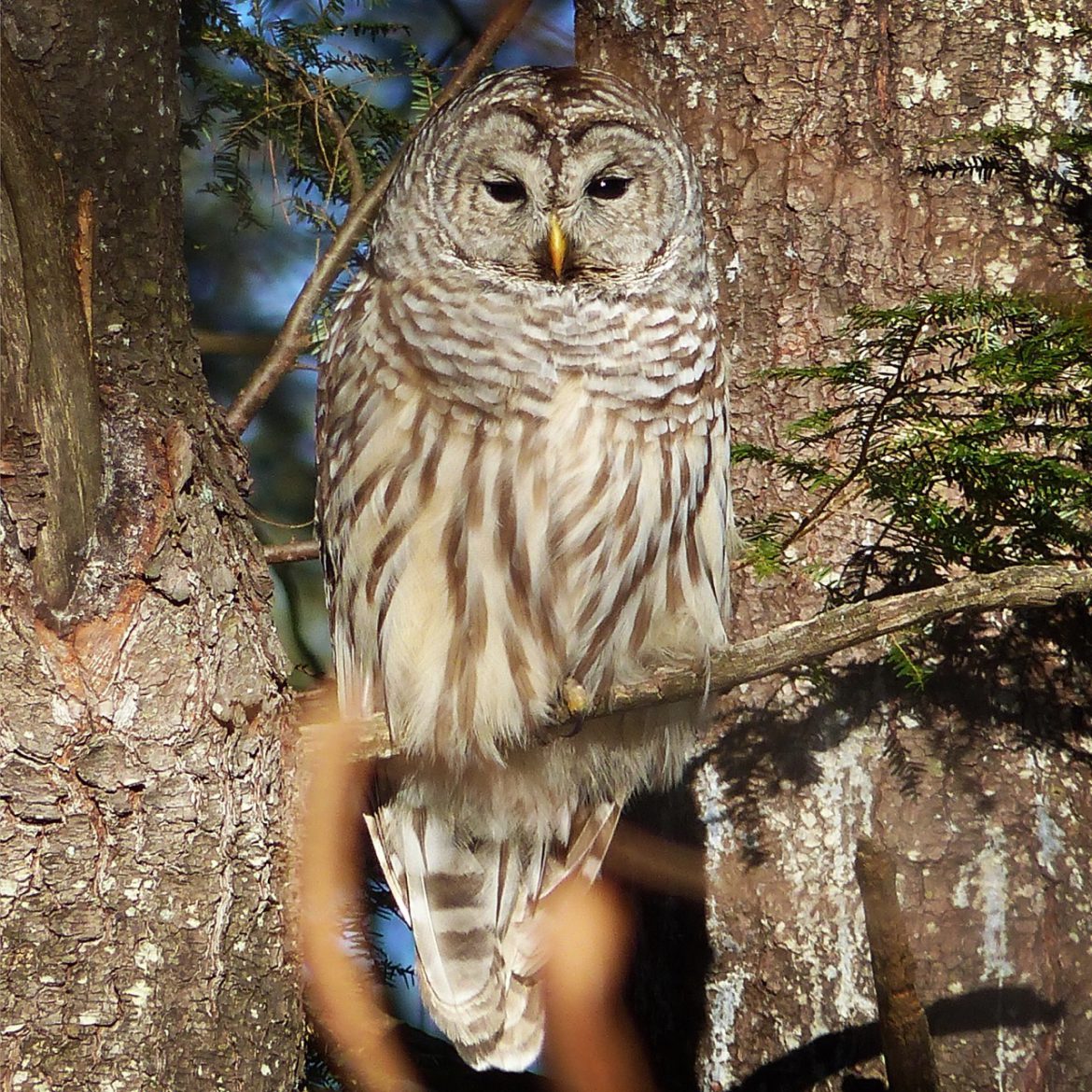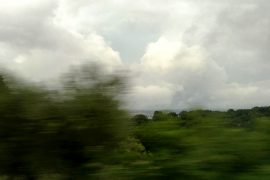We saw him first at mid-morning. I had seen out the window a swoop of wings and a settling, and I followed the gesture to the spot where a large bird now sat, streaked and stony, just inside the wood’s shadow. The three of us—my husband, my mother, and I—gathered at the window in the back bedroom to watch him, using our small spotting binoculars to get a better view of his contours and expression. He was beautiful, enchanting, but after awhile this idleness of watching made us restless, and we quit the bedroom for the warmth of the kitchen, called in by the smell of fresh Christmas tea bread warming in the oven, and the tea itself on the boil.
We were eating and sipping and chatting when my mother looked up suddenly and exclaimed, “Oh! Now the owl’s right here by the door!” The bird had pounced on some unseen quarry, and was now half-submerged in snow, his wings lightly aloft. He was not more than fifteen feet from the house, and this time when we gathered at the door to watch him, he looked straight up at us, his eyes meeting ours. These eyes were a deep coal-black, glossy and round, and his bill was a curl of yellow just in the center of his face. Around each eye was a ruffle of buff and gray feathers, a corolla that gave him an awake, penetrating look. It was hard to look away.
Perhaps the lot of us spooked him, or perhaps he had simply missed his quarry, and he retreated suddenly to a high branch at the back corner of the yard. But he quickly settled there and began another scan, twisting his head nearly half-way around, first right, then left, and then looking straight down at the snow below. And then he pounced again, landing hard, feet-first in the snow with a little plash, his head hitting lightly, too, and then raised himself up and stamped his feet once, then paused, and stamped them again. He swiveled to look this way, then that, keeping an eye for his own predators now that he was earthbound. He gave a few more stamps of his feet, and then with one powerful claw hauled from the snow a long black mole, lifeless and sagging, and placed it in his bill. Then, jerking his head once, then twice, then a third time, he swallowed it whole.
Up, and up, he lifted himself again to the trees, and without any pause began to hunt again, scanning downward, scanning the landscape, listening for the minutely audible susurration of tiny feet under snow, of fur and tail brushing channel walls, of the purr and chatter of near-blind mice as they met in surprise and greeted each other in the blue-white dim of their snowy passageways. The owl pounced again, but this time came up empty, and he moved to another part of the yard. And then, after another few attempts, he lifted away, off into the mottled gray of the winter woods, and was gone.
He was back in the afternoon, though, startling me by appearing once again through the window of the back bedroom, this time perched on a thick branch of our towering sugar maple. He saw me again, too, and our eyes met briefly, his black gaze looking deeply through me, and I felt a transfixed chill, as if it were I that was his prey. Then suddenly he broke and turned, looked down into the open plain of the yard, folded open his wings, and glided in a flawless arc to earth, landing hard in the snow once again. But at this moment my cat Rhubarb joined me at the window, and the owl looked up suddenly, startled by the cat’s appearance, and lifted up into the woods again, and again was gone.
Later, I pulled on my tall boots and my parka and gloves, and I stomped into the yard to look at all the places the owl had been. Each landing spot was a hole in the snow about six inches deep, with a small, concave indentation at one edge that could only have been the impression of his bill. Sometimes his wingtips had made a fan in the snow around the hole, and some holes were bermed with loose snow at the edge where he’d kicked his feet.
I dug into every one of these holes, looking, and everywhere I dug I found the tunnels, part of the sub-surface network of comings and goings we humans see only in late spring, when the snow is on its last breath and the channels lie half-open, the plain evidence of a once-vibrant under-snow community. But the owl sees these channels all winter, sees them precisely and with both eyes and ears, and then leaves his own tracks in the snow, his own evidence of the miracle, this everyday miracle of hunting and feeding.





Beautiful.
Thanks, Rangi.
Gorgeous imagery. Felt like I was there with you, witnessing the owl’s hunting, watching with a strange combination of admiration and fear. Great stuff.
Evan, many thanks. Praise from a writer means an awful lot.
I’m trying to reinvigorate this blog, which has languished for months without much updating. It used to be focused only on my professional work, but I’ve recently re-imagined it as my regular writing place, the place for thinking out loud, the place to practice. More to come.
The owl is back today, hunting from a perch above our bird feeder. Photos: http://bit.ly/5kUdU7